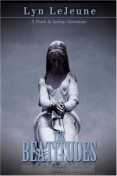BKMT READING GUIDES
The Beatitudes: Book I
by Lyn LeJeune, New Orleans Public Library Foundation
Paperback : 324 pages
0 club reading this now
0 members have read this book
Introduction
Social workers Hannah "Scrimp" Dubois and Earlene "Pinch" Washington have just started their own business, Social Investigations, to solve the murders of ten foster children in New Orleans, Louisiana. The New Orleans Police Department, the Catholic Church, and local politicians have sidestepped clues that point to those who hold great power, hampering their investigation.,/p>
As Scrimp and Pinch discover more evidence, they realize that they are dealing with a force that crosses into the realm of the paranormal. Then they are thrown into a world much like Dante's purgatory. Soon they link the murderers to a secret organization called the White Army, or La Armee Blanc, centered in New Orleans, but rooted in medieval Europe and the Children's Crusades. Each clue leads to a beatitude, the characteristics of those who are deemed blessed: the pure of heart, the persecuted, the merciful, the sorrowful, the peacemakers, the meek, the poor in spirit, and those who hunger and thirst after justice. By the time the eleventh child-the sacrificial child-goes missing, Scrimp and Pinch are determined to prevent his death.
Racing against time and the threat of an approaching hurricane, these two bold, no-nonsense women work together to restore hope and bring closure to a city battered by sin.
Excerpt
Chapter IMy best friend Pinch was murdered while I slept. The police reported that she was caught off guard, snuck up on, as Pinch would have said. I don't believe that for one blasted minute. I
know she looked her killer in the eye, sized him up, laughed, then spit in his face. It all happened before my very eyes; I had dreamed about her death over the past year. The first dream came the morning after the murder of the first foster child. Marisa was found fully clothed, wrapped in a pink swaddling blanket, as though dreaming of many tomorrows and games and parties and toys; and then eight more dreams, eight more foster children murdered, all left on the trolleys of New Orleans; then again the same dream after the presumed murderer had been arrested; and finally the last one, after I had lost my job, accused of negligence in the care of two of the slain children under my charge. And when Pinch was butchered, my dream coming horrifyingly true, my life spinning out of control, I had, for the second time in my life, lost everything, lost control, was unwittingly blown away by the winds of a dispassionate fate. Or so I thought at the time. ...
Discussion Questions
To what extent do the chapters, each named after a Beatitude, provide clues, move the story forward, and help Pinch and Scrimp find the murderers of the foster children?In what ways do The Beatitudes teach Scrimp (Hannah DuBois)) about herself and the world in which she must live after she discovers that she is a Gran Met, a voodoo priestess?
Why did the author chose Dante’s Purgatorio (the second book in The Divine Comedy) as the underlying parable for TheBeatitudes? What does the author mean when she has the dead priest, Father Delcambre, say “purgatory is diluted by time?”
How does Scrimp use her visions to solve the murders?
Why is Pinch murdered with a sword from the famous Cabildo Museum in New Orleans?
Why did the author choose foster children as the la Armee Blanc’s (The White Army)
victims? And how do the characters that run the White Army explain the historical context of The Beatitudes, particularly when the real history of the Knights of the White Camellia is considered?
What is the significance of the African American dwarf, n’est pas juste? How does his name, literally translated as “I am not justice,” explain one theme of the book, namely, that life is made up of many roads of contradiction and each individual must find his/her own correct way?
Why do Scrimp, Pinch and n’est pas juste travel to Scrimp’s old home out in the Cajun countryside? What are they looking for?
What are some underlying themes in The Beatitudes that pertains to you and your faith? Consider these ideas: free will vs. fate; hope vs. cynicism; good vs. evil; the self vs. the greater good.
What is the story about in the end? Why did Scrimp have the following words inscribed on Pinch’s headstone: SHE WAS THE ENEMY OF ALL CRUELTY?
Beatrice remained Dante’s muse and inspiration throughout his life, although she died at a very young age, and we can surely say that it was unrequited love. In The Divine Comedy, it is Beatrice who initiates Dante’s journey because she thinks that he has strayed from the path of righteousness and believes his journey through hell, purgatory, and then to paradise will save his soul. Do you think that Pinch is Scrimp’s Beatrice?
Book Club Recommendations
Recommended to book clubs by 0 of 0 members.
Book Club HQ to over 90,000+ book clubs and ready to welcome yours.
Get free weekly updates on top club picks, book giveaways, author events and more








